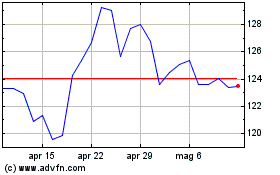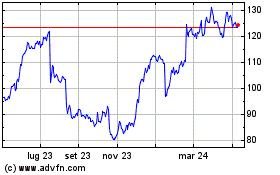AmEx Deploys Capital Robustly - Analyst Blog
27 Marzo 2012 - 11:00AM
Zacks
Basking in the glory of the excellent stress test result,
yesterday the board of American Express Co. (AXP)
(AmEx) announced an 11% dividend hike and robust stock repurchases
in an attempt to return excess wealth to investors.
The central bank of the US released its annual capital stress
test earlier this month, which put 19 large banks under the scanner
to test the resistance quality of the banking bellwethers amidst an
economic shock. AmEx emerged with flying colours, notching a seat
among the 15 banks that passed the test.
Accordingly, AmEx has raised its regular quarterly dividend to
20 cents per share from 18 cents, which is payable on May 10, 2012
to the shareholders of record as on April 5, 2012. This marks the
first dividend hike by the company since November 2007. However, it
continued to pay regular dividends through the peak recessionary
period (2008-10) unlike most of its peers who chopped off or
suspended dividedn payout over this period.
Seeking a ‘no objection certificate’ from the Federal Reserve
(Fed) on its capital distribution plan AmEx’s board also announced
its intention of buying back about 150 million shares from time to
time through open market operations. The latest sanctioned stock
repurchases substitutes the prior 200 million share buyback
program, which had about 38 million outstanding.
Additionally, based on Monday’s closing price of $58.66, AmEx’s
dividend yield currently stands at about 34%, while its stock
buyback program currently stands at about $8.8 billion. AmEx’s
market price has escalated over 24% so far in 2012 and reflects
AmEx’s potential of significantly enhancing the shareholder value
in the near future.
AmEx Fundamentals Firm
AmEx enjoys a strong capital position with a Tier 1 risk-based
common ratio of 12.3%, at the end of 2011, well above the current
regulatory requirement. Excess cash and securities of $18 billion
at 2011-end, improved deposits and strong ROE had also paved way
for resumption of share repurchases in the third quarter of 2011.
Thenceforth, the company bought back shares worth $2.3 billion in
2011, thereby distributing about 56% of capital generated through
share repurchases and dividend payments.
On a cumulative basis, since 1994, the company has distributed
about 64% of capital generated through share repurchases and
dividends. The latest acknowledgement from the Fed that AmEx’s
capital flexibility should continue to remain intact even after
capital deployment through share repurchases and dividend has
further boosted the company’s drive to continue with the share
repurchase activity in 2012 more aggressively.
Besides sustaining over 25% ROE growth, going ahead, management
expects to consistently invest 50% of its excess capital in the
business while paying out the remaining 50% to the investors
through dividends and share buybacks. Hence, according to a
regulatory statement filed by AmEx, the company anticipates to
repurchase about $4 billion of common stock in 2012, while the
remaining $1 billion of the buyback package is expected to be
completed in 2013. Nevertheless, share repurchases will be
dependent on the market conditions, the company’s business
developments and operating performance in the upcoming
quarters.
Going back to the stress test result details declared earlier
this month, 15 of the 19 top banks satisfied the Fed with their
capital requirements. While JP Morgan Chase
&Co. (JPM) was the first to announce a dividend hike,
other banking giants followed suit and included the likes of
Morgan Stanley (MS), Wells Fargo &
Co. (WFC), BB&T Corp. (BBT),
Goldman Sachs Group Inc. (GS) and Discover
Financial Services (DFS). Thus, the banking giants
showcased an improved and healthy capital flexibility since the
downturn in 2008 and looks to be en route to attain stability.
However, four banks – MetLife Inc. (MET),
SunTrust Banks Inc. (STI), Citigroup
Inc. (C) and Ally Financial failed to meet all of the Fed
criteria in the stress test.
Our Take
Fundamentally, AmEx has been driving its growth profile through
improved credit quality. Alongside, the company has been upgrading
its digital payment platform through strategic alliances, which
will not only expand the company’s card membership base but will
also help it penetrate the unexplored market and tap the upcoming
opportunities in the field of eCommerce.
Although increasing regulatory compliances, low interest rates
and higher expenses are weighing on the net interest income and
margins, we believe the long-term outlook remains firm for AmEx.
Based on the current market volatility, the Zacks Rank for AmEx
currently stands at #3, implying a short-term Hold and a long-term
Neutral stance.
AMER EXPRESS CO (AXP): Free Stock Analysis Report
BB&T CORP (BBT): Free Stock Analysis Report
CITIGROUP INC (C): Free Stock Analysis Report
DISCOVER FIN SV (DFS): Free Stock Analysis Report
GOLDMAN SACHS (GS): Free Stock Analysis Report
JPMORGAN CHASE (JPM): Free Stock Analysis Report
METLIFE INC (MET): Free Stock Analysis Report
MORGAN STANLEY (MS): Free Stock Analysis Report
SUNTRUST BKS (STI): Free Stock Analysis Report
WELLS FARGO-NEW (WFC): Free Stock Analysis Report
To read this article on Zacks.com click here.
Zacks Investment Research
Grafico Azioni Discover Financial Servi... (NYSE:DFS)
Storico
Da Giu 2024 a Lug 2024

Grafico Azioni Discover Financial Servi... (NYSE:DFS)
Storico
Da Lug 2023 a Lug 2024
